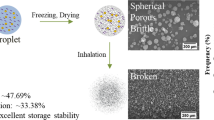Abstract
Purpose. To assess the physical stability and aerosol characteristicsof suspensions of hollow porous microspheres (PulmoSpheres™) inHFA-134a.
Methods. Cromolyn sodium, albuterol sulfate, and formoterol fumaratemicrospheres were prepared by a spray-drying method. Particle sizeand morphology were determined via electron microscopy. Particleaggregation and suspension creaming times were assessed visually,and aerosol performance was determined via Andersen cascadeimpaction and dose uniformity studies.
Results. The hollow porous particle morphology allows the propellantto permeate freely within the particles creating a novel form ofsuspension termed a homodispersion™, wherein the dispersed and continuousphases are identical, separated by an insoluble interfacial layer of drugand excipient. Homodispersion formation improves suspension stabilityby minimizing the difference in density between the particles andthe medium, and by reducing attractive forces between particles. Theimproved physical stability leads to excellent dose uniformity. Excellentaerosolization efficiencies are also observed with PulmoSpheresformulations, with fine particle fractions of about 70%.
Conclusions. The formation of hollow porous particles provides anew formulation technology for stabilizing suspensions of drugs inhydrofluoroalkane propellants with improved physical stability, contentuniformity, and aerosolization efficiency.
Similar content being viewed by others
REFERENCES
T. S. Purewal and D. J. Grant (eds.), Metered Dose Inhaler Technology Interpharm Press Inc., Buffalo Grove, IL, 1998.
C. G. Thiel. From Susie's question to CFC-free: an inventor's perspective on 40 years of mdi development and regulation. In R. N. Dalby, P. R. Byron, S. J. Farr (eds.) Respiratory Drug Delivery V, Interpharm Press Inc., Buffalo Grove, IL, 1996, pp. 115-123.
M. J. Molina and F. S. Rowland. Stratospheric sink for chlorofluoromethanes: chlorine catalyzed destruction of ozone. Nature 249: 810-812 (1974).
C. L. Leach. Approaches and challenges to use freon propellant replacements. Aerosol Sci. 22, 328-334 (1995)
I. J. Smith. The challenge of reformulation. J. Aerosol Med. 8: S19-S27 (1995).
J. Elvecrog. Metered dose inhalers in a CFC-free future. Pharm. Tech. Eur. 9:52-55 (1997).
D. A. Edwards, J. Hanes, G. Caponetti, J. Hrkach, A. Ben-Jebria, M. L. Eskew, J. Mintzes, D. Deaver, N. Lotan, and R. Langer. Large porous particles for pulmonary drug delivery. Science 276:1868-1871 (1997).
R. E. Ruffin, M. B. Dolovich, F. A. Oldenburg, and M. T. Newhouse. The preferential deposition of isoproterenol and propranolol in asthmatic patients. Chest 80:904-907 (1981).
M. A. Johnson, S. P. Newman, R. Bloom, N. Talaee, and S. W. Clark. Delivery of albuterol and ipratropium bromide from two nebulizer systems in chronic stable asthma. Efficacy and pulmonary deposition. Chest 96:6-10 (1989).
M. M. Clay, D. Pavia, and S. W. Clarke. Effect of aerosol particle size on bronchodilation with nebulized terbutaline in asthmatic patients. Thorax, 41:364-368 (1986).
P. Zanen. L. T. Go, and J.-W. Lammers. The optimal particle size for beta-adrenergic aerosols in mild asthmatics. Int. J. Pharm. 107:211-217 (1994).
Author information
Authors and Affiliations
Rights and permissions
About this article
Cite this article
Dellamary, L.A., Tarara, T.E., Smith, D.J. et al. Hollow Porous Particles in Metered Dose Inhalers. Pharm Res 17, 168–174 (2000). https://doi.org/10.1023/A:1007513213292
Issue Date:
DOI: https://doi.org/10.1023/A:1007513213292




